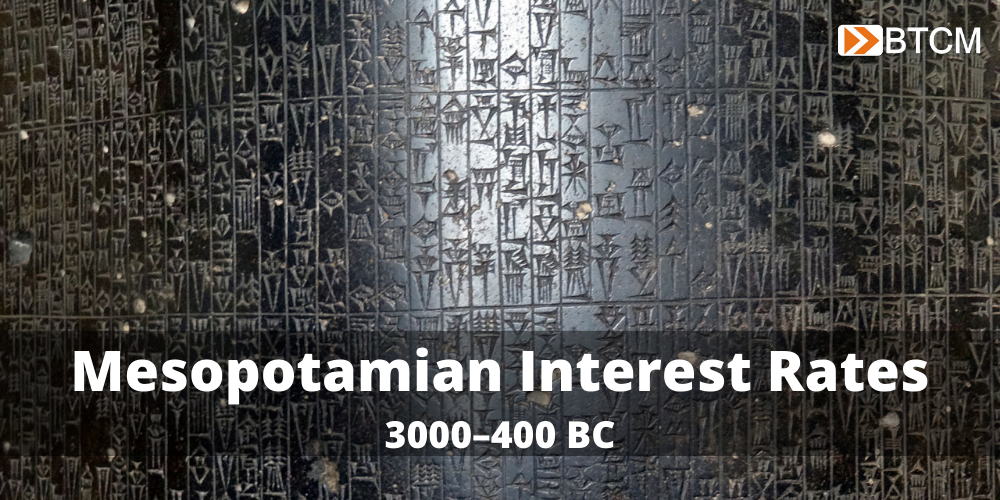Mesopotamian Interest Rates: 3000–400 BC

Author: Kent Polkinghorne
Source material: A History of Interest Rates, Fourth Edition by Sidney Homer and Richard Sylla (1963, 2005). This book covers interest rate history dating back to ancient times and contains very interesting charts, tables, and analysis which I will attempt to modernize and summarize with contemporary tools. This data can expand our understanding of different eras of monetary and financial information to make us better investors.
Ancient Mesopotamian Interest Rates
The book begins by covering interest rate data from Mesopotamia between 3000 – 400 BC. As one might imagine the amount of data on this topic is extremely sparse but, nonetheless, some of it has managed to be passed down to us. The charts below were constructed using data from Table 1 (page 31) of the book. Interest rate information concerning four of the most powerful Mesopotamian kingdoms is provided. The normal range of interest rates for loans denominated in grain or silver is provided. Within this context we have both the low ends and high ends of this range. Charts are presented in chronological order beginning with the oldest. Compared to modern rates of interest these figures will appear very high.
Sumer 3000-1900 B.C.

Babylonia 1900-300 B.C.

Babylonia also had a legal maxima in place for much of this period i.e. a cap on the highest amount of interest that could legally be charged. From 1900 to 539 B.C. the legal maxima on grain loans was reduced from 33 1/3% to 20% while the legal maxima on silver loans appears to have remained stable at 20%. There is no listed legal maxima for the period 499-300 B.C.
Assyria 899-600 B.C.

Persia 599-500 B.C.

Before moving on to the next section it is worth noting that loans would have likely been repaid in kind i.e. if you borrowed in grain you had to repay in grain.
The Nature of Ancient Mesopotamian Loans
It’s also important to provide some context on the nature of the loans being provided during these times. In modern times there are different types of loans and tradable securities for just about everything: business, consumer, auto, homes, government, etc. During these ancient times the complex debt markets that we know today did not exist. Instead, loans tended to be more personal in nature. Accounts of different types of loans, some with interest recorded, in ancient Babylonia and Assyria are provided below:
Circa 2000 B.C.: Two shekels of silver have been borrowed by Mas-Shamach, the son of A., from the sun priestess Amat-Shamach, daughter of W. He will pay the Sun-God’s interest. At the time of harvest, he will pay back the sum and interest upon it (page 29).
Assyria, probably 1000-700 B.C.: Five imer of barley belonging to the heir apparent, in the hand of Taquni II, placed at the disposal of Hamathutha of…The barley increases by 50 qua the imer (page 29).
In 667 B.C. Nergal-shar-utsin lent 5 shekels of silver at…20% (page 30).
595 B.C. One-half mina of silver borrowed by N-S from N-U on security of all his possessions, on which interest of 16.66% shall accrue each year (page 30).
The Legal Aspects of Loans and Security
The famous Code of Hammurabi governed the legal aspects of loans. For example, creditors had to wait until after harvest before they were legally permitted to pursue repayment. Crop failures due to a storm or drought effectively cancelled the payment of interest for the year in which the failure occurred. Prior to 600 B.C., the maximum amount of interest that one could charge for a loan denominated in grain was above that of silver.
The ancient borrower of a loan could pledge different types of collateral in order to secure a loan. Examples included: town houses, farms, and doors. During ancient times, doors were rare and not considered to be a part of the house. Wood was scarce so doors were actually separately salable from the house itself.
One last interesting aside, the holder of a loan would sometimes live in the house that was posted as collateral, something unheard of in modern times.
Final Thoughts on Ancient Mesopotamian Loans
Despite the lack of nuance and complexity that we are accustomed to today, a well-established legal code was in place from the earliest of times that regulated ancient lending. There were no secondary markets for treasury / government bonds or foreign exchange trading, at least not that we are aware of; however, ancient Mesopotamia had a formal structure in place to facilitate commerce via loans. Just like today, ancient loans were used to fund agricultural operations, purchases of homes, or technological innovation. Our source material even mentions international transactions taking place amongst Babylonians, Assyrians, and Hittites. Conspicuously, data is missing from Egypt, noting that their highly authoritarian economy left few records of credit and interest. The book also goes on to state that ancient Egypt operated largely without the use of a medium of exchange.
In next week’s piece, we will shift our focus to ancient Greece.




